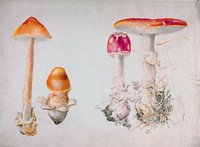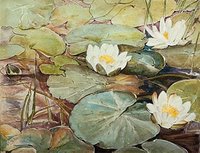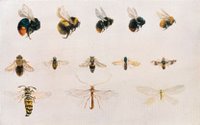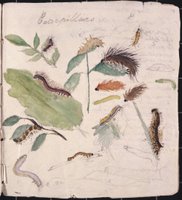 Since February 5-11 is Children’s Authors and Illustrators week I’ve decided to make a bit of a do about it here. I’ll be missing updates for the days that fall on the weekend. That’s just how I am.
Since February 5-11 is Children’s Authors and Illustrators week I’ve decided to make a bit of a do about it here. I’ll be missing updates for the days that fall on the weekend. That’s just how I am.So I’ve decided to start with one of the classic children’s authors and illustrators. Beatrix Potter. I’ve chosen Beatrix Potter simply because her life is absolutely fascinating. In fact the story behind her stories is just as interesting as their success.

I was never the biggest Peter Rabbit fan as a child. I had an English grandfather who I’m pretty sure bought me this book and I remember it quite well, but I was never in love with it. I think it sort of scared me. The constant threat of a regular person who was trying to kill and eat the protagonist (a cute little bunny) probably had a lot to do with that. But I was always drawn back to the book because of the drawings, ironically.

The message of listen to adults they’re right is both timeless and very Victorian. This was a time when children were seen, not heard. Looking at the Rabbit stories now you understand that it’s probably through similarly traumatic events that the parents have gained their knowledge. There is explicit mention of the death of Peter’s father at Mrs. McGegor’s hand. Like four and twenty black birds he was baked into a pie. It also reminds me of the Spongebob Squarepants episode where Patrick gets canned as tuna.

The art of the Peter Rabbit stories is the epitome of Victorian English storytelling. They are basically a repressed joyfulness. Potter uses watercolours, which anyone who has tried, requires patience. Patience to develop the skill of painting with watercolours and patience to actually complete a watercolour painting. In a lot of ways you need to be done before the first stroke hits the paper. These are slightly anthropomorphic characters, but remain unbelievably true to the source material. Yes they walk on their hind legs and dress up but the moment Peter loses his coat and shoes his portrait may as well be in a zoological textbook.
This realistic portrayal of the animals was honed over the years Potter was studying botany. She spent years dissecting and painting flowers and fungi. She wrote a paper called “On the Germination of the Spores of Agaricineae” that argued lichens were a symbiotic relationship between algae and fungi. A man presented this to the society of scientists as they w
 ould not admit women and it was basically rejected outright. Her uncle later tried to get her accepted at the Royal Botanical Gardens at Kew where again they refused to accept women. Potter chose not to pursue this career after these years of frustration because she was simply a woman. She did manage to keep control over her paintings and diagrams she feared would be used in textbooks without credit to her. Years later her paper was proven to be correct and I believe her watercolours are still being used today in some textbooks over photographs.
ould not admit women and it was basically rejected outright. Her uncle later tried to get her accepted at the Royal Botanical Gardens at Kew where again they refused to accept women. Potter chose not to pursue this career after these years of frustration because she was simply a woman. She did manage to keep control over her paintings and diagrams she feared would be used in textbooks without credit to her. Years later her paper was proven to be correct and I believe her watercolours are still being used today in some textbooks over photographs.It was this rejection because of her sex that prompted Potter to gather back som
 e letters she had sent to the son of her ex-governess. These letters was the background story and sketches to Peter Rabbit. She sent him a letter about the adventures of her pet rabbit I believe along with sketches that would turn into the print version. She shopped this around to some publishers and was again rejected because she was a woman. Potter then decided to print on her own which caught the eye of a publisher. The rest as they say is history.
e letters she had sent to the son of her ex-governess. These letters was the background story and sketches to Peter Rabbit. She sent him a letter about the adventures of her pet rabbit I believe along with sketches that would turn into the print version. She shopped this around to some publishers and was again rejected because she was a woman. Potter then decided to print on her own which caught the eye of a publisher. The rest as they say is history.The Tales of Peter Rabbit was an instant success that allowed Potter an in
 dependent income. With it she purchased Hill Top farm where she began breeding sheep and preserving the natural history around the Lake District. It is also where she wrote the rest of her children’s books. I think some of the sheep she helped breed are still in existence today. She was simply one to never rest on her laurels.
dependent income. With it she purchased Hill Top farm where she began breeding sheep and preserving the natural history around the Lake District. It is also where she wrote the rest of her children’s books. I think some of the sheep she helped breed are still in existence today. She was simply one to never rest on her laurels.I simply find her life fascinating. Her artwork is stellar, as I hop
 e you can appreciate from all the images in this post. The simple fact that she painted with watercolours speaks volumes to the type of person she was. She was patient and enduring – both skills required to be a good watercolourist. And there is a healthy respect for nature in her prose. Potter was raised in London with summer vacations to the Lake District and Scotland. Her parents were the Victorian equivalent to the helicopter parent (always hovering) who thought other children were a bad influence so the Potter kids found solace in nature and pets. She even had a secret diary that she wrote in code where she would snarkily review other artists. The code was only broken fifteen years after her death.
e you can appreciate from all the images in this post. The simple fact that she painted with watercolours speaks volumes to the type of person she was. She was patient and enduring – both skills required to be a good watercolourist. And there is a healthy respect for nature in her prose. Potter was raised in London with summer vacations to the Lake District and Scotland. Her parents were the Victorian equivalent to the helicopter parent (always hovering) who thought other children were a bad influence so the Potter kids found solace in nature and pets. She even had a secret diary that she wrote in code where she would snarkily review other artists. The code was only broken fifteen years after her death.
Even as a child her sketchbooks show that she was simply skilled at observing the world of nature through her art. I know a kid whose obsessed with catepillars and even I can't draw the way young Beatrice did. When she left the botanists behind she moved to insects and animals which would later become the slightly anthropomorphic characters in her stories. They were equally fantastic yet realistic.

I’m sure that reading through this you’ve come up with a million parallel cases for comic book artists and writers (especially women). I know I have. Unique vision, unparalleled talent. Yet she wasn’t accepted because it challenged the social structure of the group she tried to participate in. Potter brought new ideas and tremendous skill to botany, but was rejected. She then brought those same ideas and skill to a new place and is one of children’s lit’s greatest success stories. I see her artwork being the basis for David Wenzel’s Hobbit or David Peterson’s Mouse Guard (yet to be released but on my “can’t wait” list).
The World of Peter Rabbit - has kid friendly histories and most of the art here.
Beatrix Potter Stories online

Beatrix Potter Society
Peter Rabbit Ballet
No comments:
Post a Comment